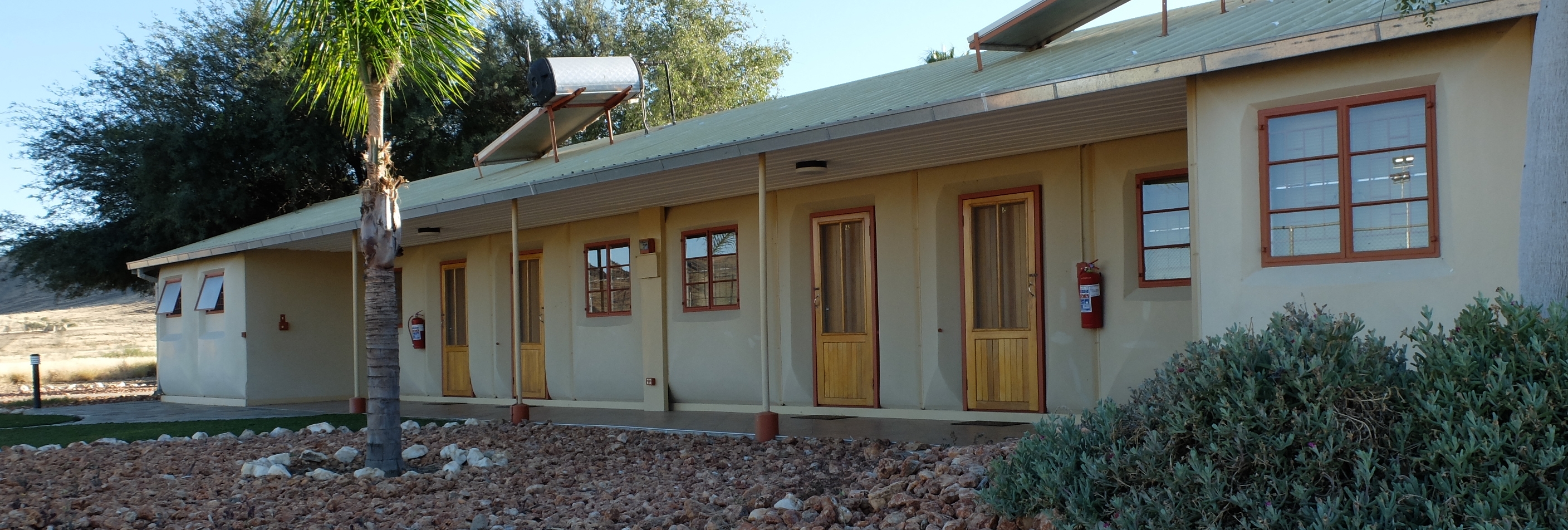The Mountain Chalet
The chalet is located about 2 km away from the ranch and offers two bedrooms, each with its own bathroom. It is equipped and furnished in stylish ambience to cater for four adults comfortably. The cozy living-dining area measures about 50m2 and offers plenty of space for lounging during the day.
An airy, shady veranda offers a magnificent view of the ranch below and the vastness of the Savanna stretching right up to the horizon.
Astronomers will appreciate the fact that the chalet is situated much higher up than the ranch. Guests may either cater for themselves in the modern and well-equipped kitchen, or else opt to enjoy a meal at the ranch restaurant.
Less than 10 meters away from the chalet two large concrete platforms, complete with an electricity socket and windbreak, are available for the vast selection of choice equipment available from Deep Sky Safaris. Travel light or complement with your own – the choice is yours.

The Ranch
Rooisand Desert Ranch accommodates guests in
- 5 cool and spacious Comfort double/twin rooms with en-suite bathrooms, placed right within an astoundingly diverse garden.

- 4 Economy Twin rooms with two single beds and an en-suite bathroom, with an unobstructed view onto the near-by Gamsberg. A near-by waterhole attracts wildlife at random.

Guest share the central area of the ranch with its thatched roof restaurant and cozy bar with easy access to the sparkling 16m long swimming pool.
Spend the day playing tennis, hiking on the farm grounds, enjoy a scenic drive, exchange a book in the library or simply relax and enjoy Namibian German hospitality and cuisine
Several observation sites are available on a huge platform stretching around the back of the tennis courts (less than a hundred meters away).
An EQ8, a Celestron CGE Pro and a Losmady G11 with FS2 on steel column is available here all year round and there is ample space for several more individual tripod mount telescope combinations.
The region
Rooisand Desert Ranch is located in the Khomas region, halfway between the capital Windhoek and the attractive coastal towns of Walvis Bay and Swakopmund, in the midst of the most magnificent sceneries Namibia has to offer. The foothills of the Gamsberg massif and its steep edge, towards the Namib Desert, are particularly stunning, geologically and archaeologically fascinating: with rugged mountains, wildly romantic river beds and breathtaking views of a boundless horizon, the deserted wild expanse stretches to the endless chains of dunes of the sandy desert in the west. This rough and mostly inaccessible land was only scantily developed by a few livestock farmers fairly recently, so that today we find a region that is so vast but so sparsely populated that it ranks high within the Dark Sky Sanctuary – an ideal for astronomy. In addition to the low rainfall/low humidity desert climate, there is clear visibility almost all year round at an altitude of 1,000 m above sea level. Despite the dry climate, the area is rich in wildlife and some game species adapted to the desert climate find particularly favourable living conditions here. Thus the (Hartmann Zebra) is almost a landmark of the region, which one frequently encounters in herds of up to 20 animals. Oryx, springbuck and ostriches thrive in this semi-desert and one often meets herds of kudu wandering along the dry river courses. The rocky landscape, with its caves as a retreat, is the ideal terrain for leopards. Graceful Klippspringer pairs on the mountain slopes and summits are also a shy and charming feature of the area.
.

Among the early inhabitants of the region were isolated nomadic Bushman clans, the indigenous peoples of southern Africa. Their legacy of archaeologically valuable rock paintings features on some of the striking rock faces on Rooisand’s terrain. Close by - along the course of the Kuiseb River - Herrmann Korn and Henno Martin spent their two-year Robinsonade, in the safety of the wasteland, fleeing detention by the English during the Second World War. Their adventurous survival is witnessed in Henno Martin's report “Wenn es Krieg gibt, gehen wir in die Wüste", which is extremely worth reading. And so - if you look closely - and listen carefully - you can hear the primaeval landscape with all its barrenness and supposed impregnability tell a story or two.
• The Sheltering Desert – Henno Martin (1956)



